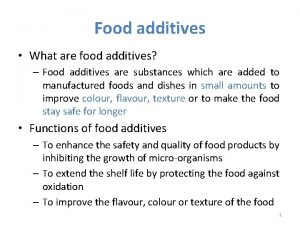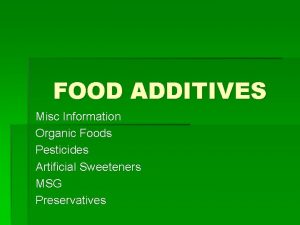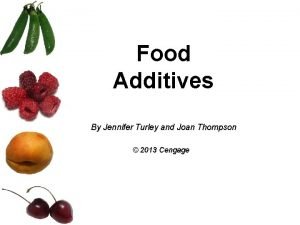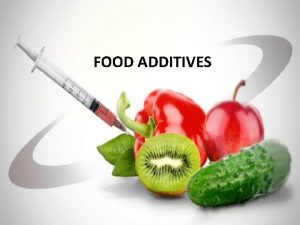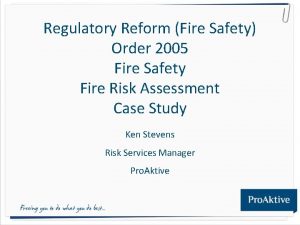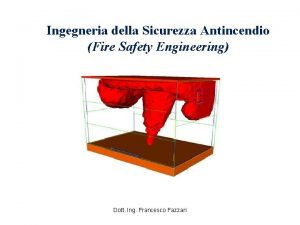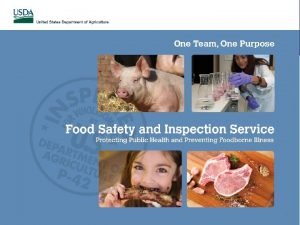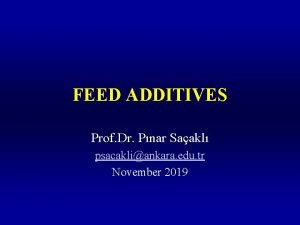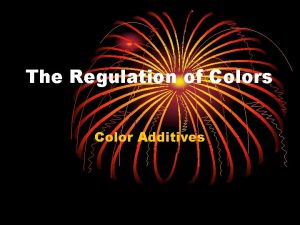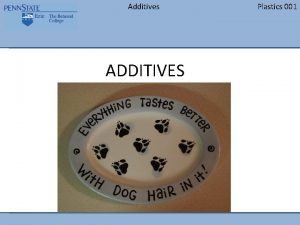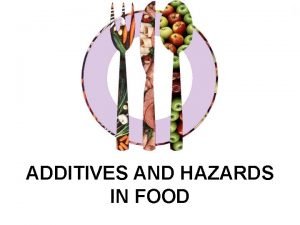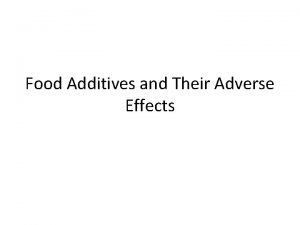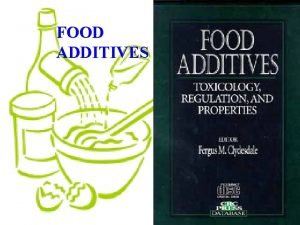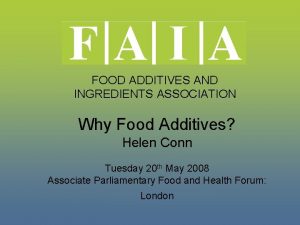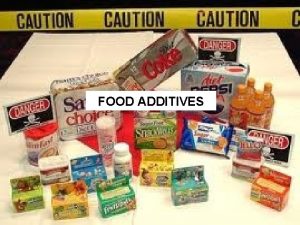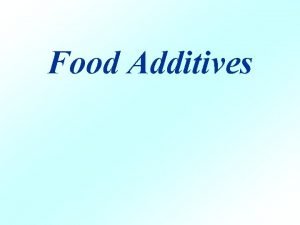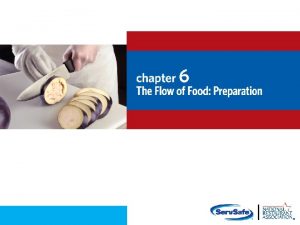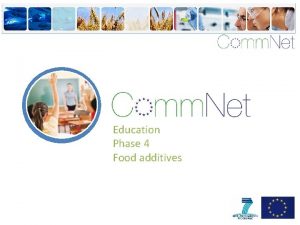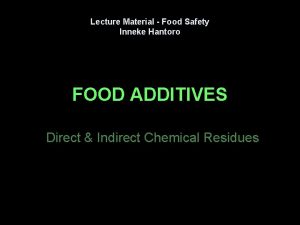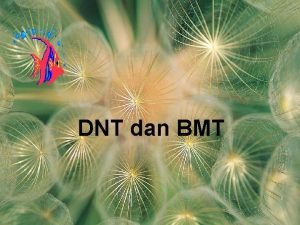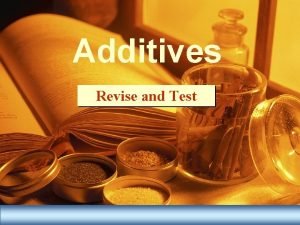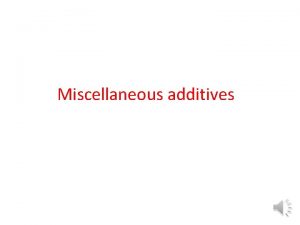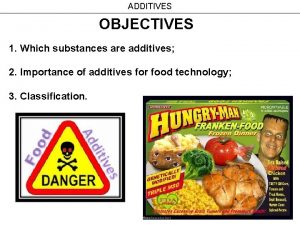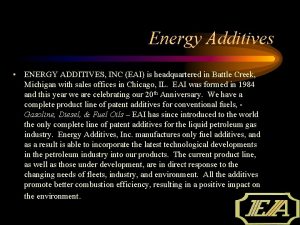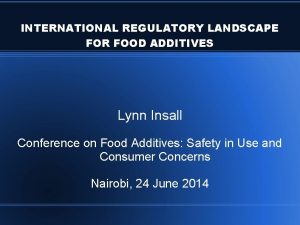1 SAFETY OF FOOD ADDITIVES THE REGULATORY ROADMAP
































- Slides: 32

1 SAFETY OF FOOD ADDITIVES: THE REGULATORY ROADMAP Manojit Basu, Ph. D Grocery Manufacturers Association (GMA)

Outline 2 GMA overview Food Additives Determining Regulatory Status - FDA Risk Assessment Process FDA Safety Standards

Grocery Manufacturers Association(GMA) 3 Founded in 1908, GMA is an active, vocal advocate for its member companies and a trusted source of information about the industry and the products consumers rely on and enjoy every day. The association and its member companies are committed to meeting the needs of consumers through product innovation, responsible business practices and effective public policy solutions developed through a genuine partnership with policymakers and other stakeholders.

GMA Member Companies General Members 4 *Represents a sample of GMA members Associate Members

GMA – Global Focus 5 Platforms for Engagement Product Safety APEC (FSCF, PTIN) GFSP Science Training Codex (ICGMA, FICC), ISO Health and Wellness APEC (advertising) LAWG WHO, FAO, Codex Trade Liberalization and Regulatory Coherence U. S. Trade Advisory Committees APEC (GRP, Export Certificates, etc. ) WTO, Codex, ISO Trade Negotiations U. S. government, bilateral, and multilateral advocacy Area of Focus

GMA Participation in Codex 6 Mission: Advance science-based international policy in Codex Alimentarius • Promoting harmonization within Codex standards and policies, and • Facilitating international trade ICGMA is accredited as an observer organization in Codex ICGMA participates in selected Codex Committees and the CAC

Food Additives - FDA 7 What is a Food Additive? � The term ''food additive'' means any substance the intended use of which results or may reasonably be expected to result, directly or indirectly, in its becoming a component or otherwise affecting the characteristics of any food (including any substance intended for use in producing, manufacturing, packing, processing, preparing, treating, packaging, transporting, or holding food); …. if such substance is not Generally Recognized As Safe (GRAS) Sec. 201(s) FFDCA: Definition

8 How much food additive do we consume? A person eats more than 1 kg of food a day, every day of the year for almost an entire life � 1 kg/d x 365 d/yr x 82 yr = 29, 930 kg/life or ~30 tons/life** A person eats approx 65 kg of direct food additives a year, every year for almost an entire life � 65 kg/yr x 82 yr = 5330 kg food additives/life** After removing the common food additives (~95%) – salts, sugar, etc. – a person eats 1. 43 kg food additives a year 1. 4 kg/yr x 82 yr. = 115 kg all other food additives/life 1. 4 kg/yr ÷ 365 d/yr. = 4 g all other food additives/d There are hundreds of direct food additives, so most are consumed in sub-milligram amounts, and not every day **Advanced Comprehensive Toxicology, American College of Toxico

Types of Food Additives 9 Added Directly to Food for an Intended Effect � Direct Additives: Sweeteners; preservatives; nutrients; fat substitutes; texturizers (e. g. , thickeners, emulsifiers); flavors � Color Additives: In food (also includes animal feed, drugs, cosmetics, and medical devices

Type of Food Additives 10 • Indirect Additives – Food Contact Substances: Coatings (paper, metal, etc. ); new/recycled plastics including polymers and monomers; paper; adhesives; colorants, antimicrobials, and antioxidants in packaging; packaging materials used during food irradiation; packaging “formulations” – Processing Aids: Antimicrobials (meat and poultry processing); defoamers; ion exchange resins

Other Food Ingredients 11 Other “Ingredients”: � Food Irradiation Equipment: To process food or to inspect food � GRAS Substances: Enzymes; fibers; proteins; lipids; carbohydrates � Foods/Ingredients Produced Via Biotechnology: Plants with herbicide resistance or insect resistance; delayed ripening, etc.

Types of Food Ingredients 12 Preservatives Fat Replacers Anti-Caking Agents Sweeteners Nutrients Humectants Color Additives Flavor and Spices Flavor Enhancers Emulsifiers Stabilizers & Thickeners, Binders, Texturizers Leavening Agents Yeast Nutrients Dough Strengtheners & Conditioners Firming Agents Enzyme Preparation Gases http: //www. fda. gov/downloads/Food. Ingredients. Packaging/ucm 094249. pdf

13 Determining Regulatory Status of a Food Ingredient Continued…

14 Determining Regulatory Status of a Food Ingredient http: //www. fda. gov/Food/Ingredients. Packaging. Labeling/Food. Additives. Ingredients/ucm 228269. htm

GRAS vs Food Additive Petition 15 Technical Element : Are the safety data adequate for the intended use? No Need Data Yes Common Knowledge Element: Are the data and information generally available and generally accepted by experts? Yes GRAS Status No Food Additive

Risk Assessment Process 16 Hazard Risk Exposu re

Hazard Determination 17 Toxicological Studies � Does the additive affect the genetic material? � Where does additive go when we consume it? � What adverse effects does the additive cause? Carcinogen* � Any effect on Reproduction? Determining No-Observed Adverse Effect Level (NOAEL) and Lowest Observed Adverse Effect Level (LOAEL) Determine an Acceptable Daily Intake (ADI) Level � ADI = NOAEL / Safety Factor (100)

Delaney Clause* 18 The Food Additives Amendment of 1958 contained what is known as the Delaney Clause � Section 409(C)(3)(A). . . no additive shall be deemed to be safe if it is found to induce cancer when ingested by man or animal, or if it is found, after tests which are appropriate for the evaluation of the safety of food additives, to induce cancer in man or animal. . . Has been invoked a few times � Aminotriazole on cranberries � Colorings: FD&C Red #3

19 Exposure Estimate (Human Consumption) Max Level of Food Additive allowed in each food / beverage Amount of each food and beverage consumed Amount of food additive consum ed

Risk Assessment Paradigm 20 Identify Hazard Characterize Dose -Response Assess Exposure Estimate Acceptable Daily Intake Estimate Human Consumption Characterize Risk

21 Safety Standards for Food Additives - FDA “Reasonable certainty of no harm” What is Harm? -Harm refers to Health -Man or Animal The safety standard for additives are higher than food. So they need to be even safer than food Petitioner burden to demonstrate a “reasonable certainty of no harm” 21 CFR 170. 3(i)

22 FDA - How is safety determined? Following factors are considered: � The probable consumption of the substance and of any substance formed in or on food because of its use � The cumulative effect of the substance in the diet, taking into account any chemically or pharmacologically related substance or substances in such diet � Safety factors which, in the opinion of experts qualified by scientific training and experience to evaluate the safety of food and food ingredients, are generally recognized as appropriate.

Establishing Safety 23 The FDA provides guidance to industry and the public concerning the procedures and methods for safety assessment of food and color additives. � "Redbook" ("Toxicological Principles for the Safety Assessment of Direct Food Additives and Color Additives Used in Food") was first published in 1982 � Latest edition of Redbook - 2000, Revised July 2007 Establish maximum exposure (Acceptable Daily Intake) based on hazard assessment Benefits are not weighed in during safety

24 Redbook: Recommended Toxicological Tests Toxicity Tests Genetic Toxicity Tests Short-term toxicity tests with rodents Subchronic toxicity studies with nonrodents One-year toxicity studies with non-rodents Chronic toxicity or Combined chronic toxicity/carcinogenicity studies with rodents Carcinogenicity studies with rodents Reproduction studies Developmental toxicity studies

25 FDA: Assessment of Cancer Risk Pathology Review Toxicology Review Mathematical Analysis Chemistry Review C A C Exposure Estimate Direct or CFSA N QRA C

Technical Review 26 FDA scientist review data and evaluate petitioner’s safety argument FDA communicates with petitioner to resolve any questions and/or additional data needs FDA review, documentation FDA reaches a scientific conclusion and makes a recommendation

Legal Aspects of Food Additive Approvals 27 Food Additives unsafe until FDA decision Regulations stipulate an identity, specifications and conditions of safe use Regulations do not provide specific product approvals Direct additives or Food-contact substance

Take Home Message 28 Historic use of Food Additives Today additives are used for adding flavor, color… Petitioner is responsible for demonstrating safety Regulated by the FDA for product safety FDA is responsible for data evaluation and issuing regulation

29 Thank You!!! & Questions? ? ?

30 Appendix

Redbook: Concern Levels 31

Redbook: Toxicological Tests 32
 Acetic acid examples
Acetic acid examples Organic food additives
Organic food additives Intentional food additives examples
Intentional food additives examples Natural and artificial food additives
Natural and artificial food additives Food technology revision
Food technology revision Food additives definition
Food additives definition Regulatory reform fire safety order 2005
Regulatory reform fire safety order 2005 Regulatory reform fire safety order 2005 summary
Regulatory reform fire safety order 2005 summary Regulatory reform (fire safety) order 2005
Regulatory reform (fire safety) order 2005 Regulatory reform (fire safety) order 2005 article 8 to 23
Regulatory reform (fire safety) order 2005 article 8 to 23 Food safety food security
Food safety food security The monophasic liquid dosage form
The monophasic liquid dosage form Polymer additives definition
Polymer additives definition Incidental additives examples
Incidental additives examples Feed additives classification
Feed additives classification High performance additives
High performance additives Fgda color wheel
Fgda color wheel Unit 2 food food food
Unit 2 food food food Food chain sequence
Food chain sequence Hình ảnh bộ gõ cơ thể búng tay
Hình ảnh bộ gõ cơ thể búng tay Bổ thể
Bổ thể Tỉ lệ cơ thể trẻ em
Tỉ lệ cơ thể trẻ em Gấu đi như thế nào
Gấu đi như thế nào Thang điểm glasgow
Thang điểm glasgow Chúa yêu trần thế
Chúa yêu trần thế Các môn thể thao bắt đầu bằng tiếng chạy
Các môn thể thao bắt đầu bằng tiếng chạy Thế nào là hệ số cao nhất
Thế nào là hệ số cao nhất Các châu lục và đại dương trên thế giới
Các châu lục và đại dương trên thế giới Công thức tiính động năng
Công thức tiính động năng Trời xanh đây là của chúng ta thể thơ
Trời xanh đây là của chúng ta thể thơ Mật thư tọa độ 5x5
Mật thư tọa độ 5x5 Phép trừ bù
Phép trừ bù
